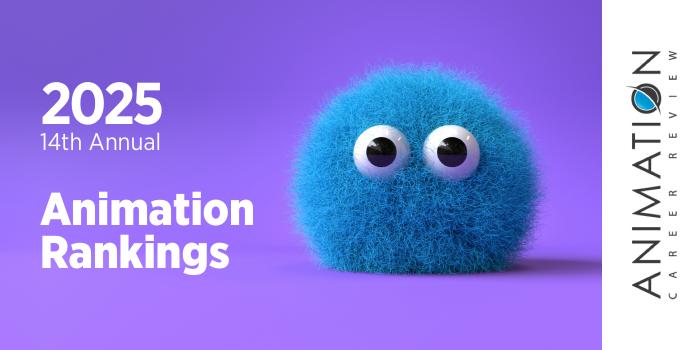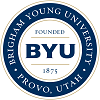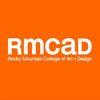
Start your career as a 2D animator for film, TV and games! CG Spectrum’s offers specialized online career training and mentorship from expert animators working at top studios. Get access to career services and a supportive community. Learn more.

| Ranking | School | State |
|---|---|---|
| 1 | Brigham Young University | Utah |
| 2 | Texas A&M University | Texas |
| 3 | University of Texas at Dallas | Texas |
| 4 | Arizona State University | Arizona |
| 5 | University of Colorado-Denver | Colorado |
| 6 | Rocky Mountain College of Art and Design | Colorado |
| 7 | New Mexico State University | New Mexico |
| 8 | University of Utah | Utah |
| 9 | Sam Houston State University | Texas |
| 10 | University of Advancing Technology | Arizona |
Our 2025 rankings -our fourteenth annual- of the Top 10 Animation Schools in the Southwest. We define the Southwest as Texas, Oklahoma, Arizona, New Mexico, Colorado, Utah, and Nevada. For an explanation of ranking criteria, click here.

Brigham Young University (BYU) is home to one of the nation’s most competitive animation programs. Established in 2010, the BYU Center for Animation accepts just 20-25 students each year. Students my gain entrance to this closed-enrollment program through BYU’s Animation BFA program or the Computer Science BS with an Animation and Games emphasis.
Throughout the BYU Center for Animation program, students will gain hands-on experience through individual and collaborative projects; faculty mentoring; and internships with major studios such as DreamWorks, Pixar, and Disney. Students will also develop advanced design and software skills. And in the junior or senior year of the program, students can specialize in anything from 3D animation to visual effects (VFX).
Housed in the Design Department in the College of Fine Arts, the Animation BFA is a limited enrollment program that accepts just 75 students per enrollment period. In this 65 credit-hour program, students will explore areas such as 3D modeling, storyboarding, character animation, compositing, previsualization, lighting, special effects, materials/shading, technical animation, and concept art.
Course examples include Experimental Animation and Production; Visual Development; Scripting for Animation; 3D Visual Effects; Technical Animation; The Joy and Beauty of Computing; Scripting for Animation; Advanced Shading; Pitching for Film and Games; Lighting for 3D Graphics; Visual Narrative; Intermediate 3D Computer Graphics; Animated Film Production 1-3; Advanced Storyboarding; Visual Development and Character Design; Directed Studies in Animation; and Business and Ethics in Animation.
Housed in the Department of Computer Science in the College of Physical and Mathematical Sciences, the Computer Science BS (Animation and Games emphasis) is a limited enrollment program that accepts just 42 students per enrollment period. Consisting of 77-81.5 credit hours, the program explores animation, visual effects, software engineering, video game production, programming, computer graphics, user interfaces, and more.
Course examples for the program include Scripting for Animation; Real-Time Techniques; Animated Film Production 1-3; Materials and Surfacing; Photography for Animation; Computer Graphics; 3D Visual Effects; Previsualization; Visual Narrative; Digital Sculpting; Lighting for 3D; and Advanced Shading; and History of Animation.
The culminating experience for all programs is the Film Animation Capstone project completed across several courses. Films are submitted to national and international competitions. BYU animation students have won awards and received recognition from the Nickelodeon Film Festival; ACM Siggraph; Cannes Film Festival; the Academy of Television Arts and Sciences Foundation; Annecy Film Festival; the Electronic Entertainment Expo; and Houston WorldFest.
Graduates of the Animation programs at Brigham Young University are prepared to pursue careers in the entertainment industry, game design and development, advertising, and many others. Program alumni have been hired at places such as Disney, Nickelodeon, Pixar, Industrial Light & Magic (ILM), DreamWorks, Blizzard Entertainment, Sony Pictures Animation, Hasbro, Riot Games, and Digital Domain.
Brigham Young University was founded in 1875 by Brigham Young—President of the Church of Jesus Christ of Latter-day Saints. The school opened as Brigham Young Academy (BYA) on January 3, 1876. On the first day of classes, the school had just 29 students enrolled. Today, Brigham Young University serves approximately 35,745 students from more than 100 countries. Campuses include BYU-Utah, BYU-Idaho, BYU-Hawaii, BYU Pathway Worldwide, and Ensign College.
One of the largest private universities in the U.S., BYU provides approximately 435 programs across dozens of colleges and departments. Brigham Young University is accredited by the Northwest Commission on Colleges and Universities (NWCCU).

The College Station campus at Texas A&M University (TAMU) serves approximately 72,560 students, making it the largest campus by enrollment in the state and one of the largest public universities in the nation. One of the few American universities to have land-, sea- and space-grant designations, TAMU also houses one of the largest visual and performing arts colleges within a public university.
The College of Performance, Visualization and Fine Arts (PVFA) is a multidisciplinary school that provides programs in film, visualization, production, dance, theater, and music. Established nearly 35 years ago, the PVFA Visualization program houses several programs for animators. These include BS, MS, and MFA degrees in Visualization.
The Visualization MFA is one of a few programs of its kind in the U.S. and possibly the only one in the state of Texas. All options allow students to explore design, computer graphics, interaction, art, and visualization. Students at all levels may focus in an area of emphasis. Options for BS students include Animation and Virtual Production; Game Creation; Interactive Design; Media Art; and Visual Computing.
BS students will also work in project-based studios on courses that explore programming, art theory, technical skills, and the production pipeline. Course examples include Principles of Design 1-3; Digital Media; Art History; 2D Visualization Techniques; Scientific and Technological Developments in Visual Arts; Computing for Visualization I-II; and Visual Studies Studio 1-3.
BS students may also participate in the Field Study course or sign up for the TAMU Internship Program. This supervised work experience lasts 15 weeks for a total of 600 hours. TAMU Visualization students have completed internships at major animation studios, graphic design firms, and game development studios.
The TAMU Visualization MS provides nine areas of emphasis including Computer Animation; Gaming; Augmented Reality (AR); Computer Graphics; Virtual Reality (VR); Interactive Design; User Experience Design; and Data Visualization. This program has both thesis (32 credit hours) and non-thesis (36 credit hours) options. Non-thesis students will complete a portfolio and capstone project to graduate.
Free electives allow all MS students to develop additional (advanced) skills in their chosen focus area. Elective examples include Generative Art; 3D Modeling and Animation; Design Communication I-III; Advanced Animation; Rendering and Shading; Computer Animation; Time-Based Media; Digital Compositing; Physical Computing for Art and Design; Image Synthesis; and Computer Aided Sculpting.
The Visualization MFA program at Texas A&M University focuses collaborative projects, innovations, team-building activities, and technical applications. In this program, students will select from eight areas of emphasis. Options include Computer Animation; Visual Storytelling; Interactive Art; Visual Effects, Gaming; Virtual/Augmented Reality (VR/AR); User Experience Design; and Data Visualization.
Course examples across emphasis areas include Contemporary Art Studio/Seminar; Professional Study; and Professional Practice. Other courses will come from core and free electives. Examples include 3D Modeling and Animation; Computer Animation; Motion Capture Animation; Virtual Reality; Form, Installation, and Environment; Advanced Animation; Generative Art; Multimedia Web Design; Interactive Virtual Environments; Advanced Game Design; Figure Drawing for Narrative and Concept Art; Digital Compositing; Augmented Reality; Physical Computing for Art and Design; and Digital image.
Students in both the MS and MFA programs will also complete a professional internship. Graduate internships are worth eight credits.
In addition, select Visualization graduate students will have the opportunity to participate in a Summer Industry Workshop. Students in this intensive course will work with professionals from major animation studios to produce professional-grade short films. The course takes place all day, every day, for 10 weeks.
Across all TAMU Visualization programs, students benefit from access to state-of-the-art facilities and studios; courses taught by accomplished instructors; student organizations such as Texas Aggie Game Developers (TAGD), Women in Animation, and Viz Industry Fair (VIF); participation in the Annual Career Fair; and the Semester Away Program in Italy, Germany, and many other countries.
A capstone project serves as the culminating experience for the TAMU Visualization BS program. MFA students will complete a professional body of work. A portion of this work must be exhibited in at least one competitive external venue approved by their advisory committee. A local exhibition of the student’s body of work is also required. This event will be coordinated with the final MFA examination.
Graduates of the Visualization programs at Texas A&M University are prepared to pursue advanced roles in the entertainment industry, among others. Visualization graduates are routinely hired at major studios such as DreamWorks Animation, Pixar, Industrial Light & Magic (ILM), Walt Disney Animation Studios, and Reel FX Animation.
Serving approximately 79,115 students, Texas A&M University is the largest university in the state and one of the top 10 largest in the nation. Founded in 1876, TAMU is also the first public institution of higher learning in the state of Texas. With two local campuses, a Health Science Center, and a campus in Doha, Quatar, Texas A&M houses 16 colleges and schools that provide approximately 415 degree programs.
Texas A&M University is accredited by the Southern Association of Colleges and Schools Commission on Colleges (SACSCOC).

University of Texas at Dallas (UT Dallas) is home to the state’s first arts and technology degree. Launched in 2002 and housed in the 50-year-old Harry W. Bass Jr. School of Arts, Humanities, and Technology (Bass School), the program is known as Arts, Technology, and Emerging Communication (ATEC). Today, the program has expanded to include BA, MA, MFA, and PhD degrees.
Across pathways, ATEC students benefit from interactions with guest speakers from major studios such as Pixar, DreamWorks, and Disney; seminars and lectures led by industry professionals; project-based exercises; and applied and experimental research in collaboration with instructors in varying areas of expertise.
For student productions, research, and other projects, the ATEC program provides access to Bass School research labs and creative practice studios such as ArtSciLab; LabSynthE; the Narrative Systems Research Lab; The Studio for Mediating Play; the Creative Automata Lab; Fashioning Circuits; the Cultural Science Lab; the 3D Studio; the Emerging Gizmology Lab; SP&CE Media; and the Public Interactives Research Lab (PIRL).
Students also have access to the ATEC Animation Lab. A major component of the lab is the simulated animated studio experience (SASE). Over two semesters, a crew of 40 SASE students will have the opportunity to design, write, produce, and direct a two-minute CG animated short film. Examples of past productions include Bad Timing (2022), Octo Ninja (2021), Night Shift (2020), and Stargazer (2019).
Within the UT Dallas ATEC program are several options for animators. The BA program has an Animation and Games (A&G) concentration. MA and PhD students may focus their studies in animation, science and technology, games, or other areas. ATEC MFA students may specialize in Animation or Creative Practice. All graduate level programs provide advanced study in computer-based arts, interactive media, technology, digital media, and professional practices.
ATEC coursework for the BA option explores computer animation, game studies, user interface and user experience (UI/UX) design, motion graphics, and digital fabrication. Course examples include Animation Origins and Techniques; Programming for Digital Artists; Drawing for Animation; Computer Animation; Lighting and Composition; Scripting for Animation; Game Design; Rigging; Level Design; Modeling and Texturing; History of Visual Effects; Animation and Game Fundamentals; and Time-Based Media.
Students will also complete 30 semester credit hours of required electives. Examples include Animation Lab I-II; Virtual Environments; Procedural Animation; Character Design; Motion Capture Animation; Game Production Lab I-II; Stop Motion Animation; Virtual Reality; Animation Studies; Storyboarding; Experimental Animation; Motion Design Lab I-II; Topics in Animation; and Real Time Texturing.
Depending on the program, culminating experiences may include a capstone project, thesis, or research project. Most experiences have an exhibition component.
Graduates of the ATEC programs at UT Dallas are prepared to pursue careers in areas such as 3D computer animation, game design and development, virtual environments, medical and scientific visualization, advertising, modeling and simulation, architecture, publishing, law, education, and training. Program alumni have been hired at companies and studios such as Disney, Blizzard Entertainment, 900lbs of Creative, Cisco Systems, JP Morgan Chase, Texas Instruments, AT&T Foundry, and Gearbox Software.
University of Texas at Dallas began as the Graduate Research Center of the Southwest (GRCSW) in 1961. The owners of Texas Instruments established the center to create better higher-education opportunities in North Texas. Today, UT Dallas is an official member of the University of Texas System, and a Carnegie R1 Doctoral Institution.
The school also serves approximately 29,865 students enrolled in more than 150 degree programs across seven schools. University of Texas at Dallas is accredited by the Southern Association of Colleges and Schools Commission on Colleges (SACSCOC).

The Herberger Institute for Design and the Arts at Arizona State University (ASU) was created in 2009 after the ASU College of Design and the Katherine K. Herberger College of Fine Arts merged. Today, Herberger employs more than 600 faculty members that serve nearly 9,000 students enrolled in 130 different programs across the School of Art; the School of Arts, Media and Engineering; the Design School; The Sidney Poitier New American Film School; ASU FIDM; and the School of Music, Dance and Theater. The Herberger Institute also houses the ASU Art Museum.
The School of Art and the School of Arts, Media and Engineering provide several paths to study animation. In the School of Art, students can enroll in the Art BFA with a concentration in Animation; the Art MFA; or the 18 credit-hour Animation minor. School of Arts, Media and Engineering students can enroll in the Digital Culture BA program; the interdisciplinary 21 credit hour undergraduate minor; or the 18 credit-hour Digital Culture certificate.
The Digital Culture BA features a variety of courses that allow students to focus in animation. Examples include Introduction to Computer Animation; Experimental Video Art; 2D Computer Animation; 3D Tools; Stop Motion Animation; Introduction to Animation for Film; Animating Virtual Worlds; 3D Computer Imaging and Animation; Fundamentals of Sound Art; and Motion Graphics and Animation. The program culminates with a final project.
Graduates of the Digital Culture BA program at Arizona State University are prepared to pursue roles in areas such as animation and film, video game development, media arts, computing, and graphic communications.
The Art BFA with a concentration in Animation requires 120 credit hours of study. Courses for the program are led by industry professionals with expertise in animation filmmaking, emerging technology, and computer-generated imagery. Course examples include Animation Motion Studies; The Art Experience; Storyboarding and Narrative Sequencing; 3D Computer Imaging and Animation; Illustration; and Junior Animation Projects I-II.
Elective options for the program allow students to gain experience in other areas such as stop motion animation, visual effects (VFX), experimental video art, game art, and screenwriting.
Other Art BFA/Animation program benefits include access to state-of-the-art facilities and resources at the Media and Immersive eXperience (MIX) Center in Mesa, Arizona; internships with local studios, companies, and arts organizations; visiting artist lectures supported by the School of Art galleries, the Ceramics Research Center and Archive, and the ASU Art Museum; and participation in public exhibitions.
The Art BFA program at Arizona State University culminates with the Animation Capstone completed across two courses. The capstone results in an independent short film or a full-length film produced as a team.
The Art MFA program at ASU Herberger provides the opportunity to complete projects in a discipline of the student’s choice. Examples include animation, intermedia, drawing and painting, photography, and printmaking. Other program benefits include workshops; teaching opportunities; visiting artist lectures; and access to private, state-of-the-art studio space at Grant Street Studios.
Located in downtown Phoenix, Grant Street houses several galleries and resources such as printmaking presses, a computer lab and 3D print lab, and a photography darkroom.
The Art MFA program at Arizona State University culminates in a solo thesis exhibition in Step Gallery, Northlight Gallery, or Harry Wood Gallery. All galleries are part of the School of Art.
Graduates of the Art BFA/Animation and MFA programs at Arizona State University are prepared to pursue careers in the creative, technical, and scientific industries, among others. Examples include animation and film, robotics, medical illustration, scientific and data visualization, games and game development, cinema and television, AR/VR, illustration, and fine arts.
ASU Art and Animation alumni hold titles such as Animator, Creative Director, VFX Artist, Graphic Artist, Art Director, and Multimedia Designer.
Founded on March 12, 1885, Arizona State University is the state’s first higher education institution. The school opened its doors on February 8, 1886 as Territorial Normal School (TNS). On the first day of class, TNS welcomed 33 students to a four-classroom building in Tempe, Arizona. Today, ASU sits on 1,550 acres that house multiple campuses, 16 colleges and schools, and ASU Online. Approximately 152,810 students from across the U.S. and nearly 160 other countries have access to more than 800 degree programs.
Arizona State University is accredited by the Higher Learning Commission (HLC). Engineering at ASU is accredited by the Engineering Accreditation Commission of ABET.

University of Colorado Denver (CU Denver) is a public urban research university that encompasses some of the oldest areas in the city. Examples include Tivoli Student Union (housed in a former brewery), and Ninth Street Historic District. CU Denver also houses the College of Arts and Media (CAM), home to the Department of Visual Arts (VA) and the Digital Animation Center (DAC).
Students in the CAM Visual Arts BFA program will learn and create in the DAC, which is a state-of-the-art facility that houses labs, studios, and production areas. This includes include 100 workstations outfitted with the latest industry 3D software including Maya, Houdini, and ZBrush; a large volume Vicon Motion Capture System; and a dedicated render farm with more than 4,300 cores.
Other Visual Art BFA features include internships at major studios such as Pixar, Disney, and NBC Universal; study abroad experiences in places such as the UK, Greece, Italy, France, and South Korea; and access to the CU Denver Comcast Media and Technology Center (CMTC). The CMTC is a partnership between CAM and the College of Engineering and Applied Science (CEAS) that focuses on research and development in everything from artificial intelligence (AI) to the performing arts.
The Visual Art BFA program at University of Colorado Denver also houses a 3D Graphics and Animation emphasis. Course examples for the program include Animation Foundations; Surfacing and Lighting; Advanced Character Animation; Modeling I-II; Introduction to Animation and Rigging; Production Practices; Creating Visual Story; Art History Survey I-II; Digital Cinematography; 3D Design; Dynamic Simulation; International Perspectives Through Animation; and Production I-III.
In the beginning of the third year of the 3D Graphics and Animation program, students will start production on the Senior Film requirement. This 18-month Capstone experience is a collaboration across departments in the College of Arts and Media. Animation students will work in all areas of design and production to create an industry-ready film, which will be screened at the Visual Arts Thesis Exhibition at Redline Contemporary Art Center or other venue.
To date, CAM 3D Graphics and Animation graduates have produced works that have been screened at more than 300 film festivals across 22 countries. Program graduates have also won more than 75 Best Animated Short awards in non-student categories.
CU Denver CAM alumni also work in a variety of roles at major companies and studios across the U.S. Examples include Disney, Nickelodeon, Sony, LucasArts, Pixar, HBO, Industrial Light & Magic (ILM), Google, Apple, AEG Live, Comcast, and Rolling Stone. Some CAM alumni also go on to launch their own independent studios or freelance businesses.
University of Colorado Denver opened in 1912 as an extension of the University of Colorado Boulder. The school became the University of Colorado Denver Center in 1965. In 1973, the UC Denver Center became University of Colorado Denver, making it an independent campus. Today, CU Denver serves more than 15,000 students enrolled in approximately 115 degree programs across seven colleges and schools. University of Colorado Denver is accredited by the Higher Learning Commission (HLC).

Rocky Mountain College of Art and Design (RMCAD) is accredited by the National Association of Schools of Art and Design (NASAD). The school houses an Animation Department with a collaborative BFA in 2D Animation or 3D Animation. Consisting of 123 credit hours, the program curriculum has a liberal arts component that emphasizes critical awareness, information literacy, and global consciousness.
Both 2D and 3D Animation students will take courses that explore texture mapping; storyboarding; character design; line of action; modeling; and observational drawing. Each option requires 27 credit hours. Designed for students interested in traditional animation, the 2D Animation program requires 21 credits in animation and six studio elective credits. With a focus on computer animation, the 3D Animation program requires 18 credits in animation and nine in studio electives.
Across programs, students will learn the 12 principles of animation and master software such as Adobe Creative Cloud including Photoshop; Toon Boom Harmony; Autodesk Maya; and Storyboard Pro.
Course examples include The Art of Villainy; Digital Painting for Film and Games; Experimental Animation; Character Animation and Motion Studies; Character Rigging; 3D Computer Lighting and Materials; Fundamentals of Animation; 3D Character and Production Design; Creative Visualization; Video Editing and Sound Design for Animation; Scriptwriting for Animation; Tools and Techniques of Contemporary Animation; 2D Computer Animation I-II; Animation Layout and Production; 3D Computer Animation Motion Studies; Stop Motion Animation; World Building; and Special Topics.
At the sophomore, junior, and senior levels, Animation BFA students will participate in intensive portfolio reviews. The culminating experience for the programs is the final project and presentation. Programs can be completed in four years, with year-round online and on-campus courses.
Graduates of the Animation BFA programs at Rocky Mountain College of Art and Design are prepared to pursue roles across the entertainment, games, and advertising industries. Program alumni have been hired at major networks, companies, and studios such as Nickelodeon, Pixar, Industrial Light & Magic (ILM), Cartoon Network, Blizzard Entertainment, LAIKA, Sony Pictures Animation, Walt Disney World, Warner Bros., Microsoft, Epic Games, Adobe, Design Republic, and Pentagram.
Rocky Mountain College of Art and Design opened in 1963 as Rocky Mountain School of Art. Serving more than 1,000 students, RMCAD provides 16 degree and certificate programs in campus/hybrid and online formats. In addition to NASAD accreditation, Rocky Mountain College of Art and Design is accredited by the Higher Learning Commission (HLC).

New Mexico State University (NMSU) is a NASA Space Grant College and home to the state’s first Honors College. The school also houses the Creative Media Institute for Film and Digital Arts (CMI). Designed for students seeking intensive training in digital filmmaking, animation, and storytelling, the CMI is a department in NMSU’s College of Arts and Sciences.
Housed in the NMSU College of Arts and Sciences, the CMI features state-of-the-art production facilities including an animation lab, digital projection screening room, production spaces, and post-production labs. The CMI is also home to the Bachelor of Creative Media with an emphasis in Animation and Visual Effects (BCM-ANVE); the Digital Filmmaking BCM; and an 18 credit-hour Animation and Visual Effects minor.
The cross-disciplinary BCM-ANVE is a 120 credit-hour program with two paths including 2D Production, and 3D and Visual Production. The paths have a common core. Courses include Beginning 2D Animation; Foundations of 3D Animation; Storyboarding; Writing for Animation -or- Screenwriting; Digital Illustration Techniques; Principles of Story Across the Media -or- Narrative: Principles of Story Across the Media; Introduction to 3D Modeling; Screenwriting; and History of Animation.
2D Production students will take additional courses such as 2D Compositing and FX; Motion Graphics; Sets and Environments; Advanced 2D Animation; Character Design and Development; and Acting for Animation. 3D and Visual Production students will take courses such as 3D Animation; Visual Effects; Light, Shade, Render; Rigging for 3D Animation; Previsualization; and Motion Capture Techniques.
Students in both options will complete the 3D Production Studio I-II courses, culminating in a short film to be presented in a showcase.
The Digital Filmmaking BCM at New Mexico State University requires 120-123 credit hours of study. This includes 27 elective credits allowing students to specialize in animation. Of the 27 elective credits, 21 are at level 300 and above. This means, students will also develop advanced skills animation and film. Course examples include Visual Effects; Advanced Screenwriting; Sound Design I-II; Digital Video Production I-II; Directing I-II; Directed Studies; Writing for Animation; Practicum; Film Crew I-II; Storyboarding; Pre-Production Management; and Business of Filmmaking/Animation.
In the final year of the Digital Filmmaking BCM program at New Mexico State University, students will complete FDMA 497: Portfolio Design and Development. During this course, students will focus on marketing strategies, building their portfolios and resumes, and developing individual demo and promotion packages.
All BCM students are eligible to enter their films or animated productions into the Las Cruces International Film Festival. Entry is free for NMSU students.
NMSU CMI graduates are prepared to pursue careers in entertainment, television production, advertising, and more. Across programs, NMSU students have interned with, completed co-op experiences with, or been hired at companies, studios, and organizations such as Disney, Amazon, NASA, IBM, Rolls-Royce, Tyson Foods, GEICO, the City of Las Cruses, Lockheed Martin, and Cummins, Inc.
Founded in 1888 as Las Cruces College, New Mexico State University is a system of five colleges that serves approximately 22,710 students. Las Cruces serves approximately 15,410 students, making it the largest campus in the NMSU system. More than 100 programs are provided across seven colleges and the graduate school. New Mexico State University is accredited by the Higher Learning Commission (HLC).

University of Utah (The U) houses the College of Fine Arts. Within the college is the Department of Film and Media Arts, which provides two paths to study animation: the Animation emphasis in the Film and Media Arts BA program and the Animation Studies minor. The BA requires 122-123 credits, with at least 39 in the emphasis. The Animation Studies minor requires a minimum of 19 credit hours, with at least 12 credit hours in animation.
Required courses for the minor include Making Movies and Introduction to Animation Techniques. Students may select one course from four drawing and mapping courses. For the remaining credits, students will select from the following courses: Introduction to 3D Animation; 3D Character Animation; Traditional Animation Production; Animation: Then, Now, and Next; Animation Film History; Japanese Anime; Storyboarding/Visual Storytelling; and Exploring Movement Through Animation. The culminating experience for the minor is an animation project.
To kick off the Film and Media Arts BA program, students will complete four courses. These include Introduction to Film and Media Arts; History of Film and Media Arts: Origins to 1952; Making Movies; and History of Film and Media Arts: 1952 to the Present. For the Animation emphasis, students must also complete Introduction to Animation Techniques; Storyboarding/Visual Storytelling; Introduction to 3D Computer Animation; and Exploring Movement through Animation.
For the remaining courses, students will select from at least 15 different courses. Examples include Contemporary Animation: The Simpsons to South Park; Digital Effects and Compositing for the Screen; Japanese Anime; 3D Character Animation; Drawing the Human Head and Hands; Traditional Animation Production; Animation: Then, Now, and Next; Digital Drawing; and Animation Film History.
All Animation students will work and learn in state-of-the-art production facilities, classrooms, and studios. Students will also have opportunities to compete an internship, participate in workshops, and attend seminars. And thanks to The U’s Learning Abroad program with University Studies Abroad Consortium (USAC), Animation students have access to more than 50 programs in 26 countries.
The Film and Media Arts BA at University of Utah culminates with the Animation Project. Completed across an advanced four-credit course, the project allows students to complete an independent animated production using the techniques of their choice.
Graduates of the creative and technology programs at University of Utah have found success as animators, game artists, directors, filmmakers, advertising animators, storyboard artists, and VFX artists. Some alumni have been hired at places such as Lucasfilm and Nickelodeon. Others have gone on to launch their own studios. This includes Pixar Animation Studios, which was co-founded by University of Utah Computer Science alum Edwin Catmull.
University of Utah is the state’s flagship institution of higher learning. The school opened on February 28, 1850 as University of Deseret. Classes were held in private homes for $8 per quarter. Today, University of Utah is a Tier 1 research university that sits on 1,534 acres. The school also serves more than 36,000 students enrolled in over 200 programs across 17 colleges and schools. University of Utah is accredited by the Northwest Commission on Colleges and Universities (NWCCU). The school is also a member of the Association of American Universities (AAU).

Sam Houston State University (SHSU) has some of the largest and most diverse programs in the academic world. The school houses the only Professional Golf Management program in Texas and one of the nation’s oldest speech and debate programs. With a full-service courtroom, and the headquarters of the Texas Forensic Science Commission, SHSU’s criminal justice program is also one of the largest programs of its kind in the U.S.
One of Sam Houston’s most diverse programs is the Animation BFA. Housed in the College of Fine Arts and Mass Communication’s Department of Art, the program explores storyboarding, 2D and 3D animation, lighting, 3D modeling/rigging/texturing, character design, and rendering. Program highlights include the portfolio reviews by industry leaders; the guest speaker series; and SHSU SIGGRAPH. This self-governed student-run organization features on-campus exhibitions, student-led workshops, and collaborative animation and other digital art projects.
Courses and projects for the SHSU Animation BFA program take place in state-of-the-art classrooms and studios such as the PC Lab with 20 workstations and 20 Cintiq Pro 16 – creative pen displays; a dedicated production studio for stop motion and 3D printing; a dedicated space for audio recording; and an additional lab with 20 HD interactive pen displays.
Program facilities are outfitted with other equipment and software such as professional studio lighting; ZBrush, Dragonframe, Maya, iPi Motion Capture, Mudbox, and Pixar’s RenderMan; animation lightboxes; and HD-TVs for displaying student work.
The SHSU Animation BFA program requires 120 credit hours including the University Core Curriculum; the Art Department Foundation; the Art Department Core, and 45 credit hours of Animation coursework. Upon completion of Foundation requirements, all BFA students will participate in the Art Department BFA Portfolio Review before being admitted to the Animation major.
The major includes the following required courses: History of Animation; Experimental Animation; Character Animation; 2D Animation; Shading, Lighting and Rendering; Introduction to 3D Animation; Animation Concepts and Techniques; Advanced 3D Animation; and Animation Preproduction. The program culminates with the final Animation Portfolio course.
Graduates of the Animation BFA program at Sam Houston State University are prepared to pursue careers in animation, filmmaking, video games, television, virtual and augmented reality (VR/AR), interactive media, advertising, and education. Graduates may also pursue roles in emerging areas for animators such as AI-powered animation, UX design, healthcare, and sustainability. Others have gone on to pursue graduate studies at SHSU, Savannah College of Art and Design (SCAD), Florida State University (FSU), Texas A&M University (Texas A&M), Southern Methodist University (SMU), and University of Texas at Dallas (UT Dallas), among others.
SHSU Animation BFA alumni can be found at places such as Zynga, EA Mobile, Powerhouse Animation, 900lbs of Creative, Kiloo Games, Perkins+Will, Rio Bravo Productions, Next Level Design Company, Stoic Studio, Jacobs Visual Media Group, JHT Incorporated, Softway Solutions, Brown Distributing Company, and the Texas Public School System.
Sam Houston State University was founded in 1879 as the Sam Houston Normal Institute. When it opened, the institute became the first teacher preparation program in Texas. Today, SHSU serves approximately 21,040 students enrolled in baccalaureate, professional, and graduate degree programs in more than 170 fields of study. This includes America’s first PhD in Forensic Science. Programs at SHSU are housed across eight colleges.
Sam Houston State University is accredited by the Southern Association of Colleges and Schools Commission on Colleges (SACSCOC).

University of Advancing Technology (UAT) is one of the few 100% STEM-based universities in the U.S. The school also follows a Synchronic Learning Model that emphasizes independent and collaborative learning in real-world environments. While UAT programs are provided on-campus, online, or a combination of the two, all students have access to mentors and state-of-the-art production facilities. And whether students study on-campus or online, internships are a graduation requirement.
For aspiring animators, University of Advancing Technology has a Game Art and Animation (GAA) BA program that allows students to work in real game production environments with programmers and designers. Consisting of 120 credit hours, the program focuses on immersive courses that teach students how to create 2D/3D art and animation for mobile, virtual reality (VR), PC, online, and console games.
Course examples for the program include Introduction to Game Art and Animation; Visual Effects Compositing; Game Art and Animation Fundamentals; Virtual Reality World Building; UI Design and Animation; 3D Modeling Environments and FX; Materials, Shaders and Lighting; 3D Modeling Characters and Vehicles; Storyboarding; VR/AR User Experience Design; and Production Studio.
The UAT GAA BA program also requires completion of the Student Innovation Project courses I-III. Though not required, courses such as Introduction to AI and Analytics, Digital Asset Creation, and Java Programming are highly recommended. In addition to the required internship, students will have opportunities to participate in community projects and apprenticeship experiences.
The Game Art and Animation BA program at University of Advancing Technology culminates with a final project, portfolio, and presentation. Graduates are prepared to pursue positions in all areas of animation and game design. Sample job titles include Animator, Character Animator, Game Artist, Texture Artist, Senior Animator, Storyboard Artist, Art Director, and Environment Animator.
UAT alumni can be found at places such as Sony Entertainment, Gearbox Publishing, FabCom, Amazon, American Gaming Systems, eBay, and GoDaddy.
Founded in 1983 as the CAD Institute, University of Advancing Technology is a private, family-owned institution that serves around 1,000 students from the U.S. and overseas. The school provides nearly 25 degree programs in areas from business and innovation to cybersecurity and virtual reality. Programs lead to the associate, bachelor, or master’s degree. University of Advancing Technology is accredited by the Higher Learning Commission (HLC) and the Council for Higher Education Accreditation (CHEA).